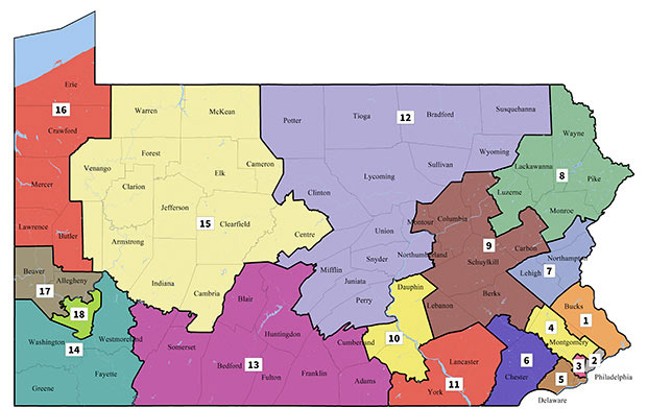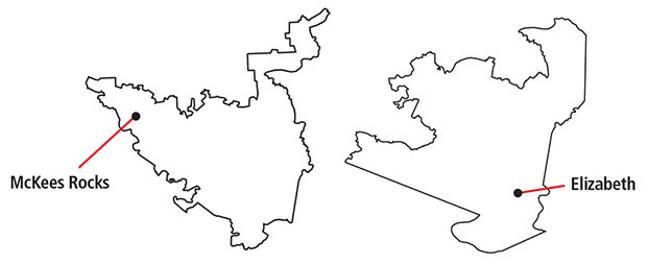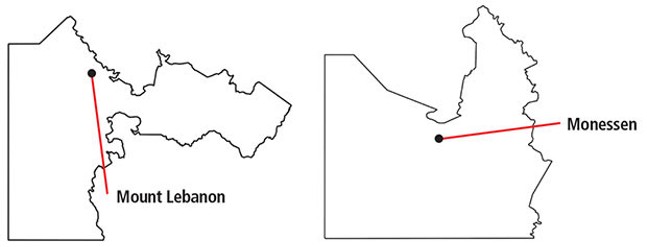Some big changes could be coming in terms of who represents who in Southwestern Pennsylvania.
On Feb. 19, the Pennsylvania Supreme Court issued its new drawings of U.S. Congressional District maps for the state of Pennsylvania. The previous maps, drawn in 2011, were deemed a partisan gerrymander by the court. State Republicans have challenged the new maps in federal court, and it is scheduled to be heard by three Republican jurists.
If the new maps come to fruition, districts in the Pittsburgh area will see big swings in partisanship-index scores, which rate how Democratic- or Republican-leaning districts are. Those changes appear to benefit Democratic candidates more in Southwestern Pennsylvania and across the state.
Since the earlier map was adopted in 2012, Republicans have held 13 of 18 congressional districts. David Wasserman, of the nonpartisan Cook Political Report, wrote on Feb. 20 of the new maps: “Democrats have an excellent chance to win at least half the state’s 18 seats.” That includes a new potential swing district in Pittsburgh’s suburbs, the newly drawn 17th District.
The new maps dissect far fewer county borders, and are more compact with fewer border miles than the current districts. Here are the breakdowns of the changes to the region’s congressional districts and, if implemented, how they will affect voters and candidates.
PA-12 to new PA-17
The district currently held by U.S. Rep. Keith Rothfus (R-Sewickley) is arguably the most gerrymandered in the region. The current 12th District stretches from Lawrence County to Somerset County, passing through northern Allegheny County, while it skirts the Ohio and Allegheny rivers, but leaves out many Democratic-voting towns along those rivers.
That changes with the new 17th District. Towns like Millvale, Sharpsburg and Bellevue would be included in a district comprised of Beaver County, suburban communities in western and northern Allegheny County, as well as a small section of Butler County’s Cranberry Township, south of Interstate 76.
Cook’s partisan-index score is Republican +11.1 for the current 12th District, but only Republican +3.2 for the new 17th District, which means it might be challenging for Rothfus to maintain his seat.
And while the new 17th District generally follows natural and man-made borders, it crosses the Allegheny River to grab the Democratic strongholds of Oakmont, Verona and Penn Hills, and also crosses Interstate 79 to include Democratic-voting communities like Mount Lebanon and Dormont.
This also sets up some confusion for current 18th District candidate Conor Lamb (D-Mount Lebanon). Lamb is running in a March 13 special election unaffected by the new maps, but he will have to choose whether to join a crowded field in the new 17th District, for a Democratic primary election on May 15.
PA-14 to new PA-18
U.S. Rep. Mike Doyle (D-Forest Hills) currently represents the 14th District, and he indicated to the Pittsburgh Post-Gazette on Feb. 20 that he will run in the new 18th District.
The biggest geographical change the new 18th District will see is losing the Democratic-voting towns along the Ohio and Allegheny rivers of the current 14th District. Traditionally Republican-voting communities of Plum and Upper St. Clair are also added to the new 18th District. These changes have made the new 18th District more Republican-leaning than the current 14th District, but still solidly Democratic.
Cook’s partisan-index score is Democratic +17.1 for the current 14th District and Democratic +12.6 for the new 18th District. The new 18th District also includes the home of current 18th District special-election candidate Rick Saccone (R-Elizabeth).
But Saccone told Washington County’s Observer-Reporter on Feb. 21, that after the March 13 special election, he will run for the new 14th District seat, instead of the new heavily Democratic 18th District. U.S. Representatives are not required to live within the district they are running for, just within the state. Saccone’s home in Elizabeth Township is just a mile from the new 14th-District boundary.
PA-18 to new PA-14
Since former U.S. Rep. Tim Murphy (R-Upper St. Clair) resigned midterm in disgrace, the current 18th District has no representative. Saccone is running to replace Murphy in a special election, as is Lamb.
So far, only Saccone has said he’ll run in the new 14th District, and no Democrats have publicly stated interest in running there. And Republicans will have a better chance at winning this new district. Cook’s partisan-index score is Republican +13.5 for the new 14th District, while the current 18th District had a score of Republican +10.8.
Geographically, the new 14th District is pretty straightforward. The district fully includes Washington, Greene and Fayette counties, as well as the western half of Westmoreland County, including towns like Greensburg and New Kensington.
The biggest difference is that Mon Valley towns in Washington, Greene and Fayette counties will now be part of more compact district. Presently, these river towns are part of the current 9th District, which stretches north to Indiana County and east to Chambersburg, in Franklin County.





